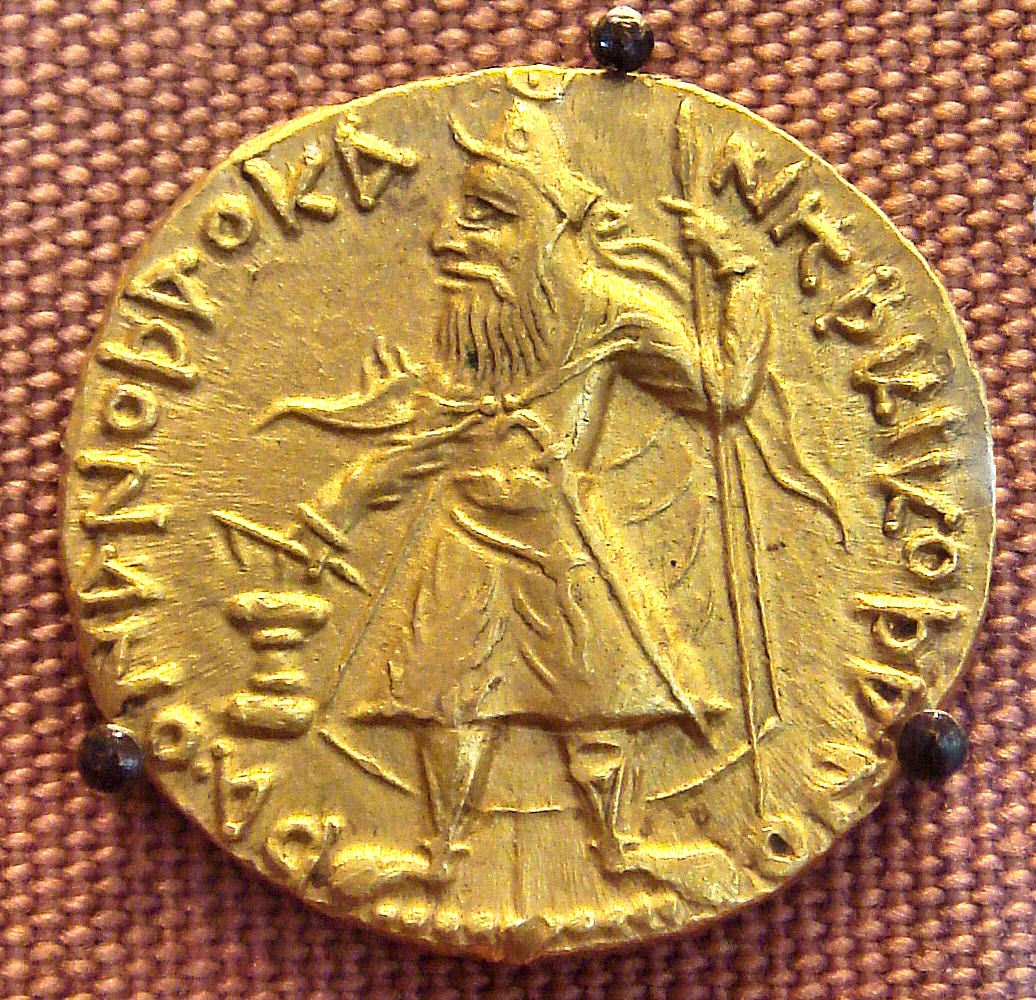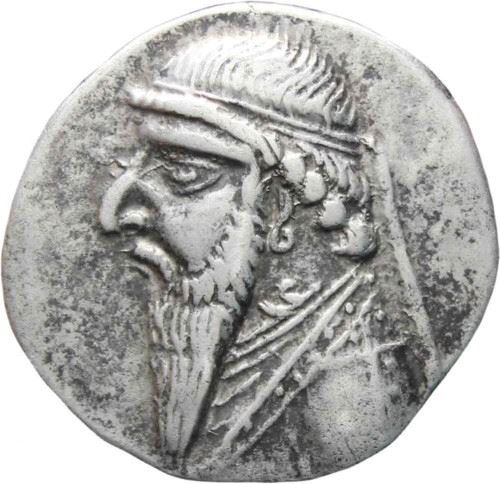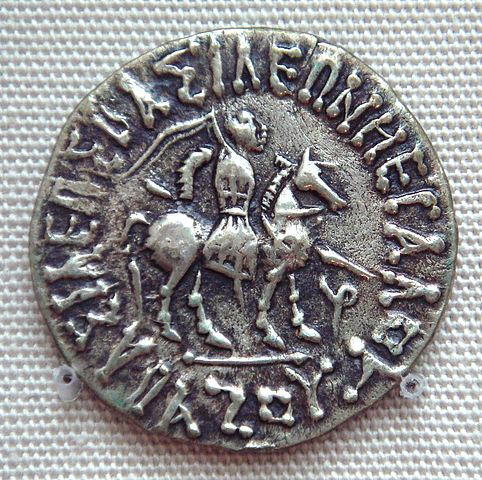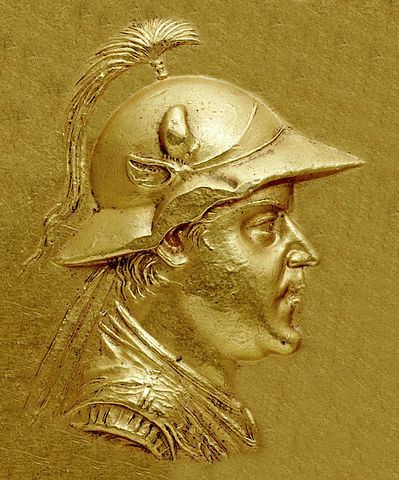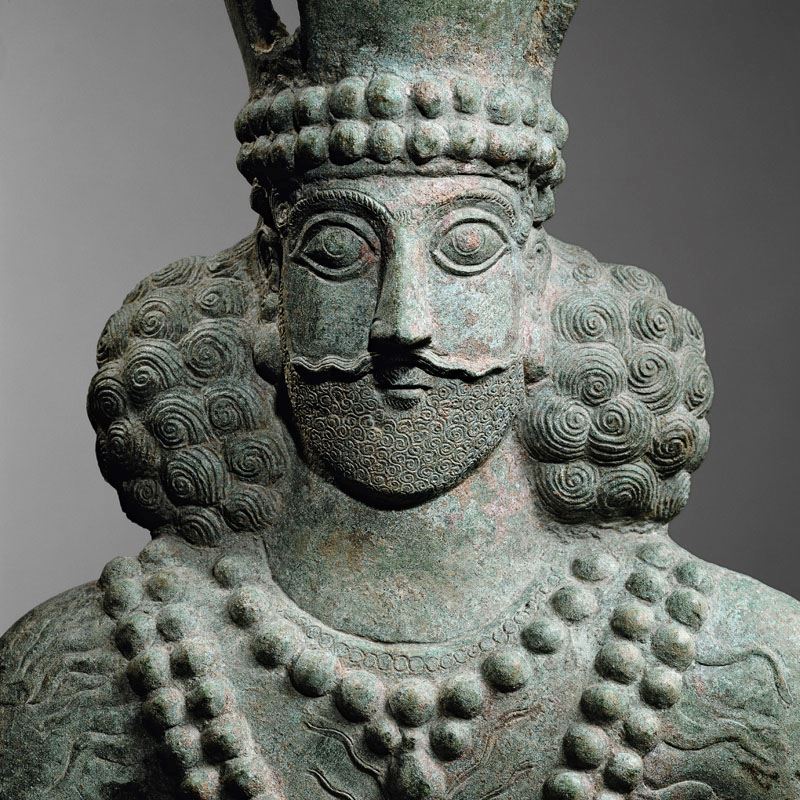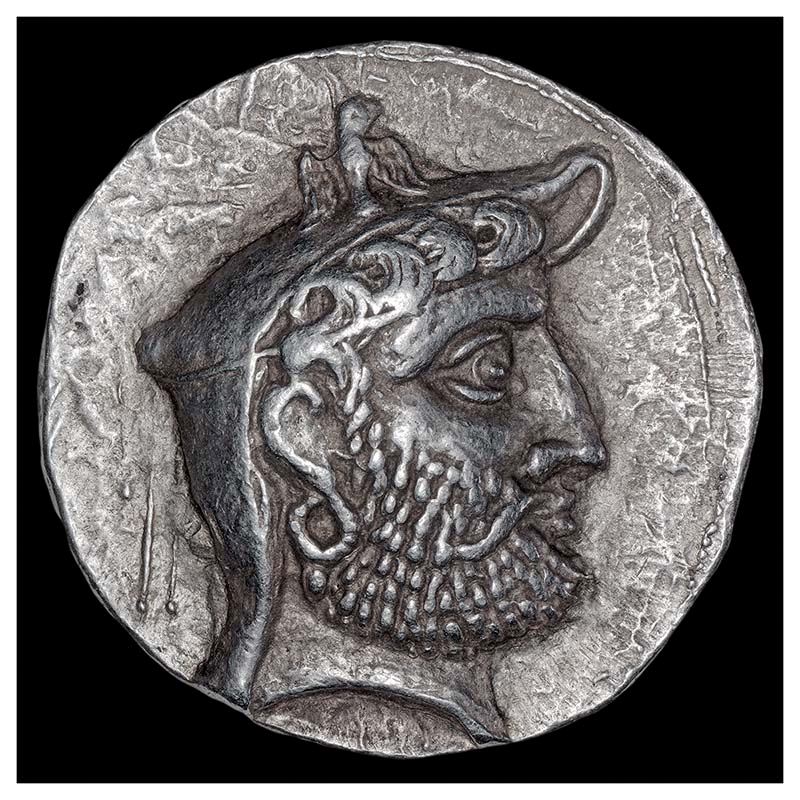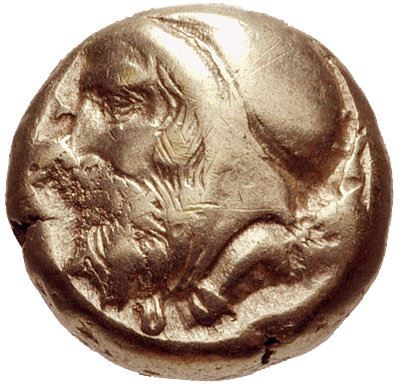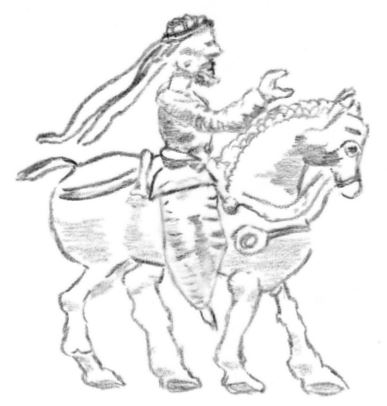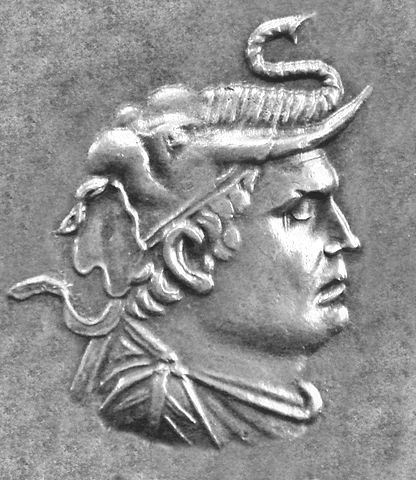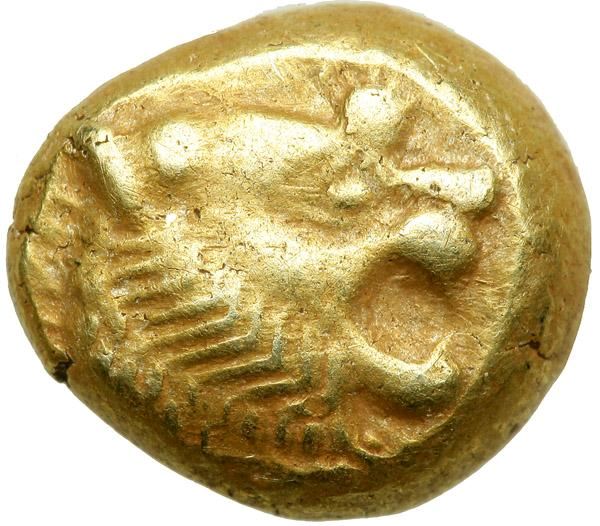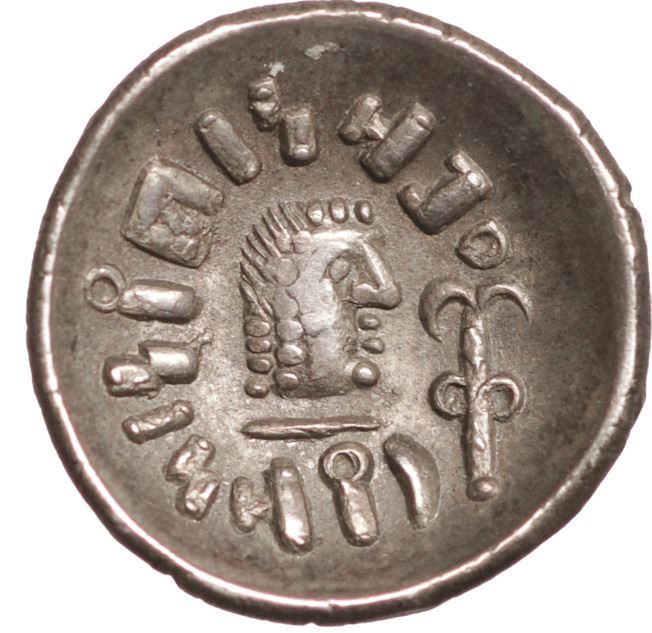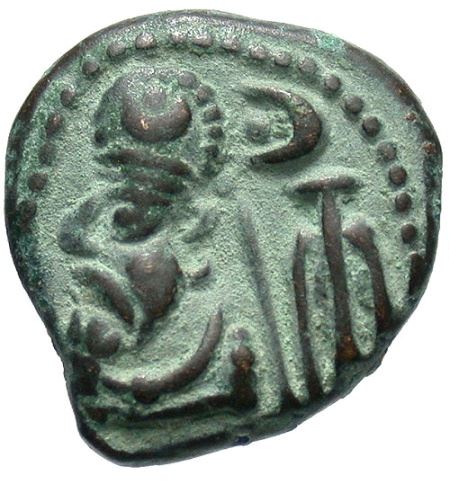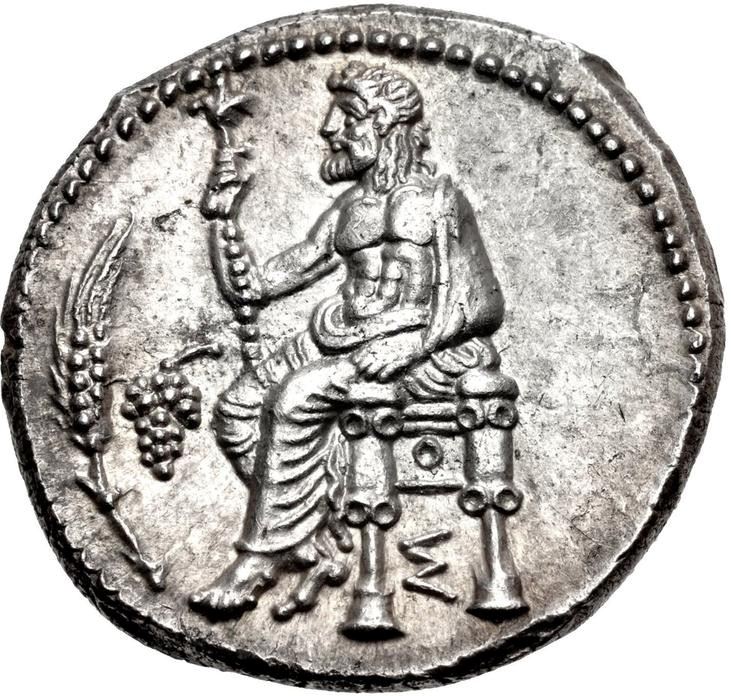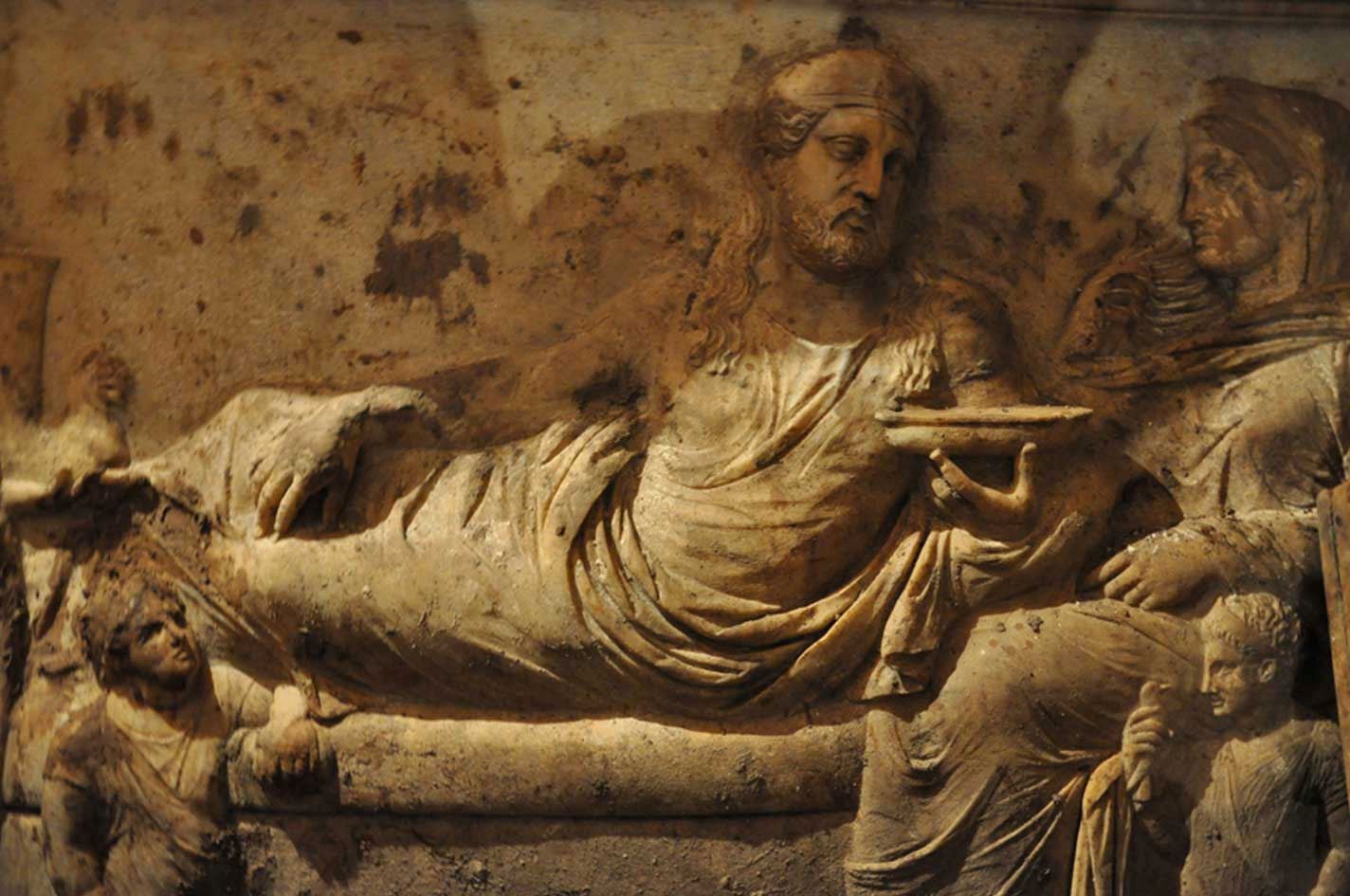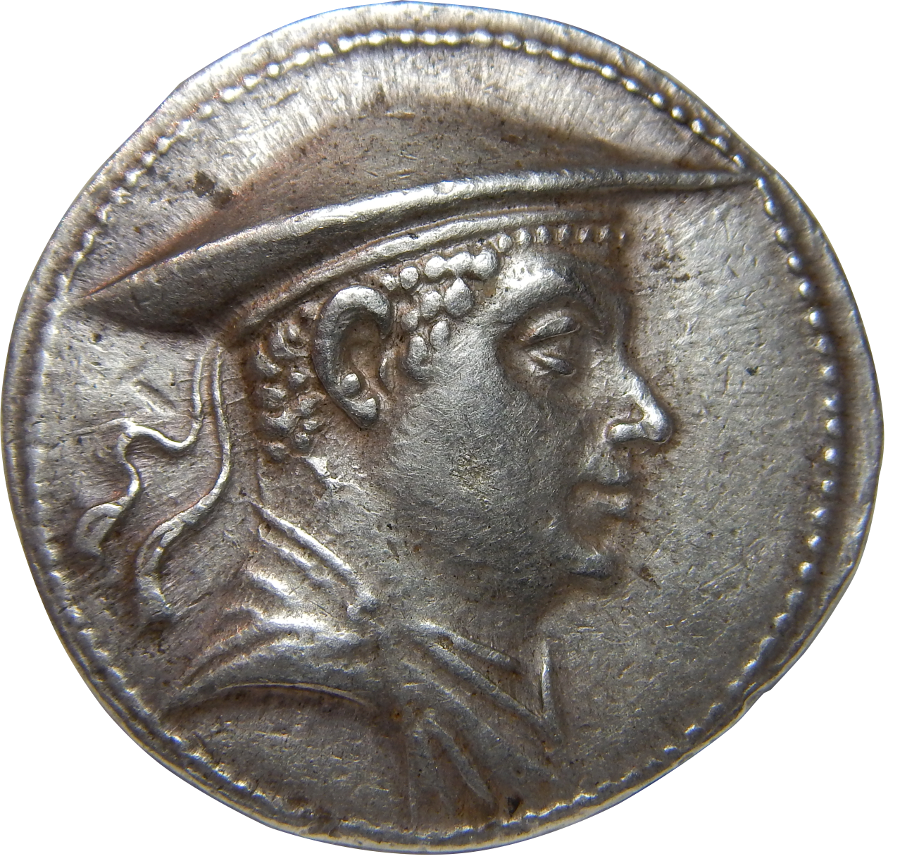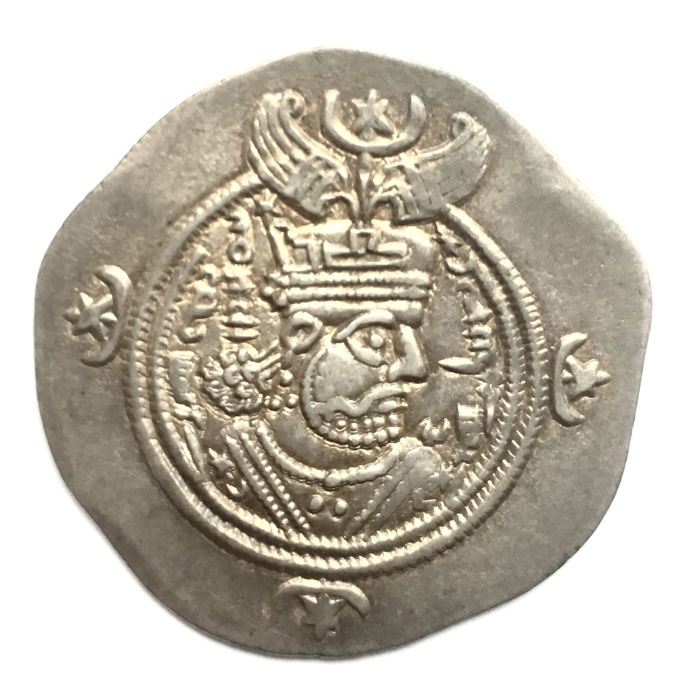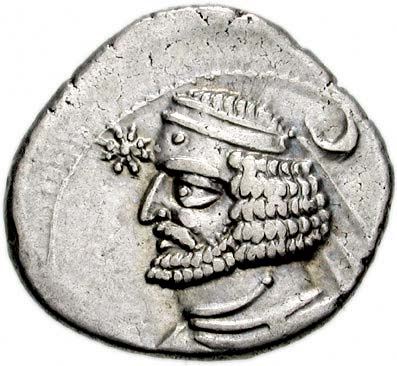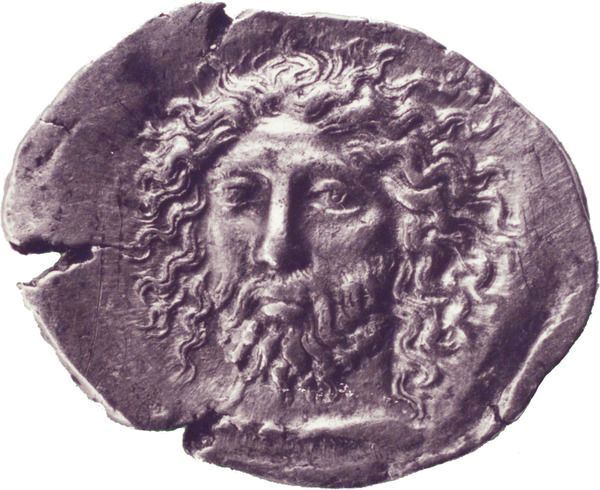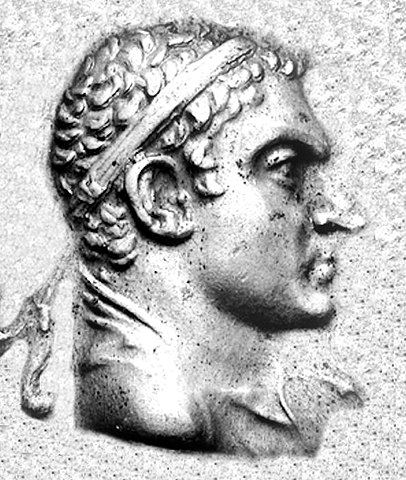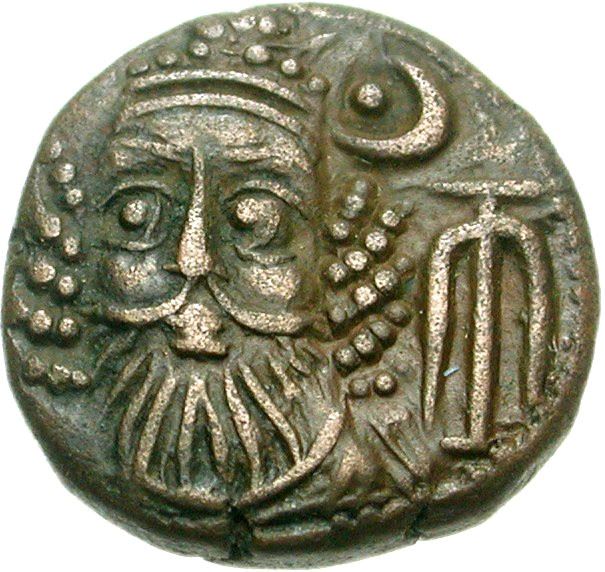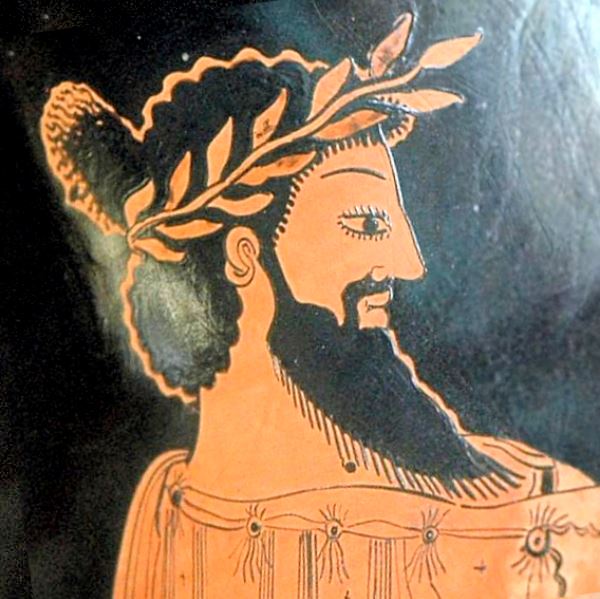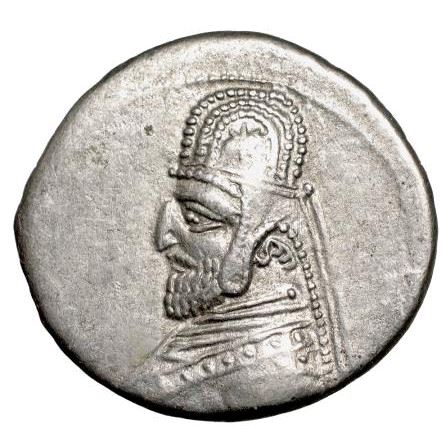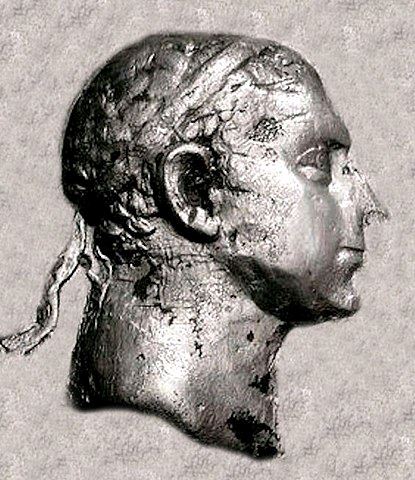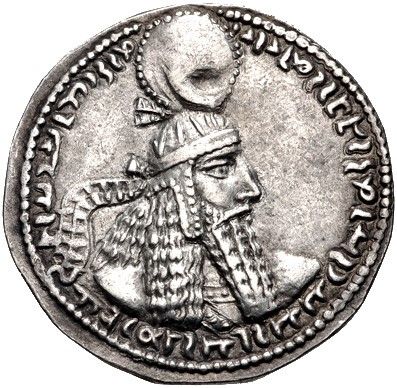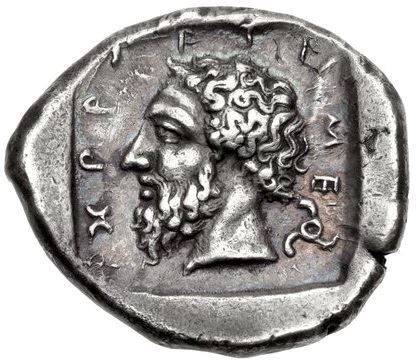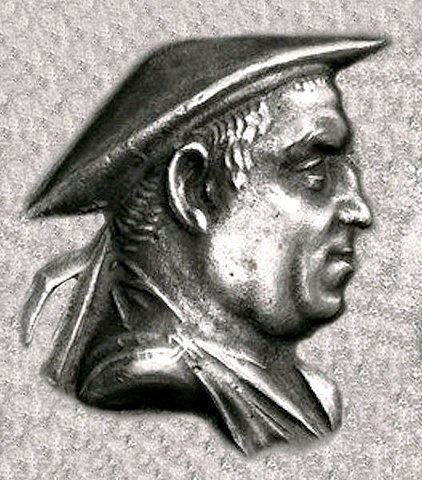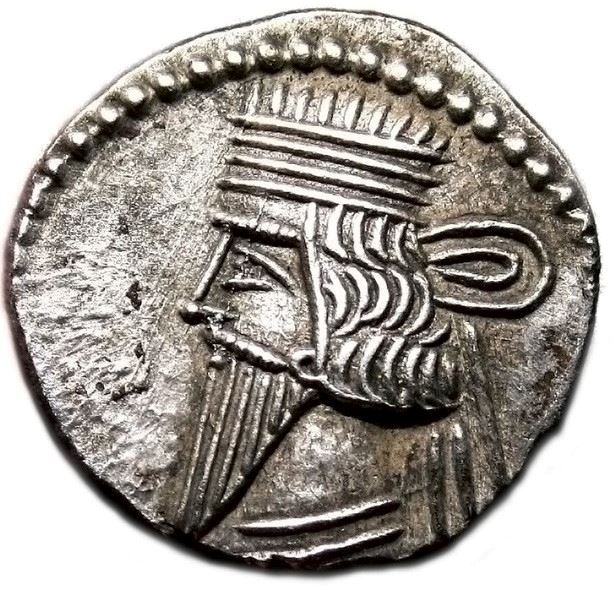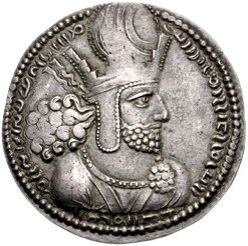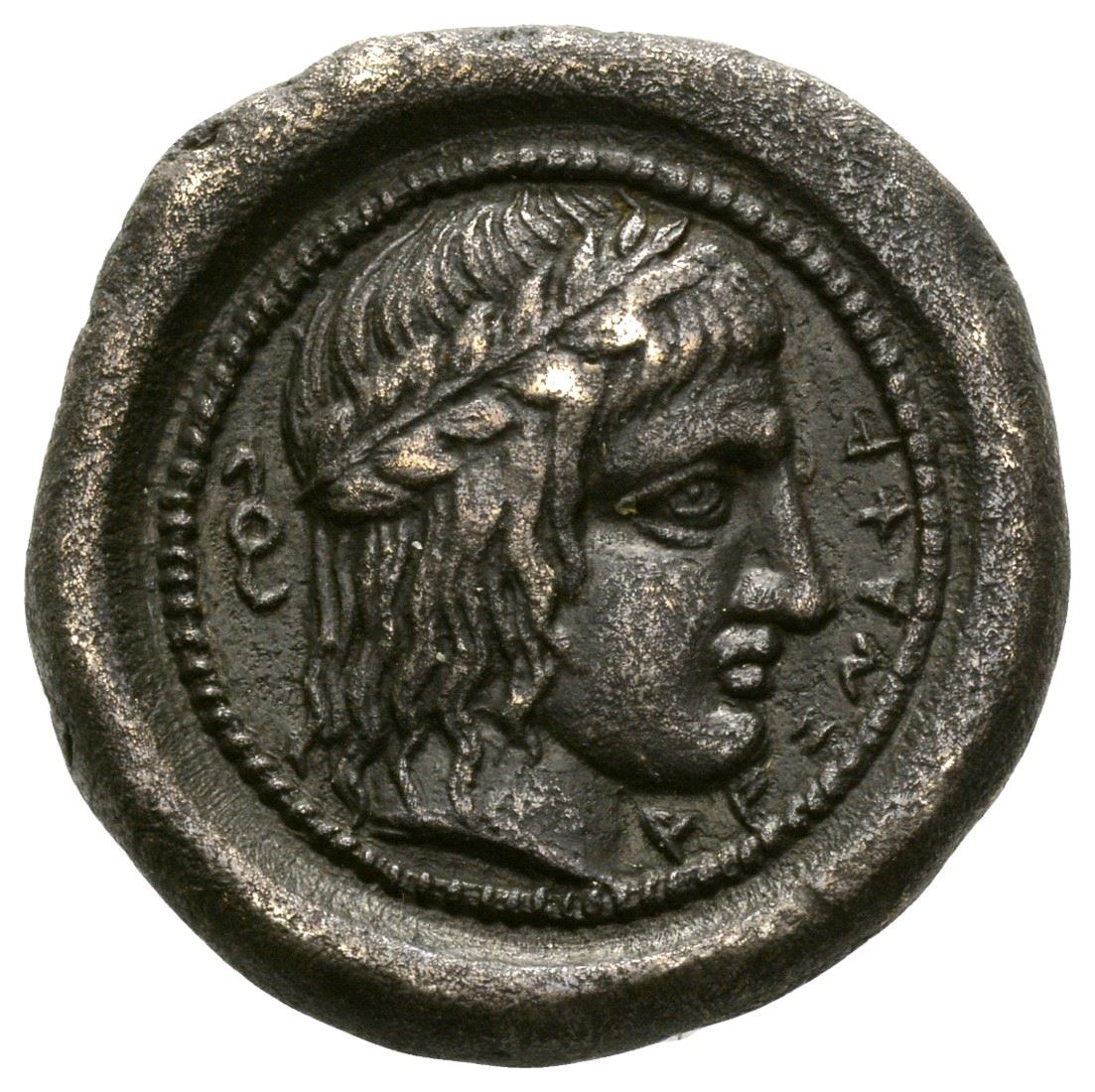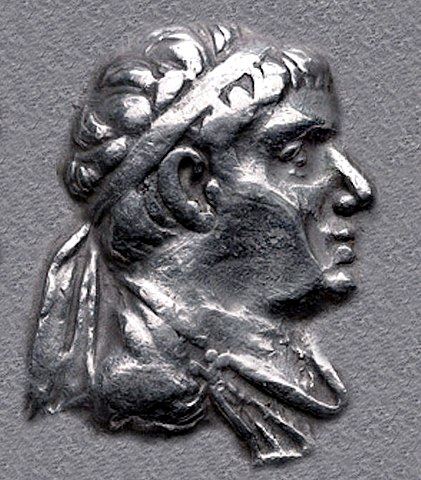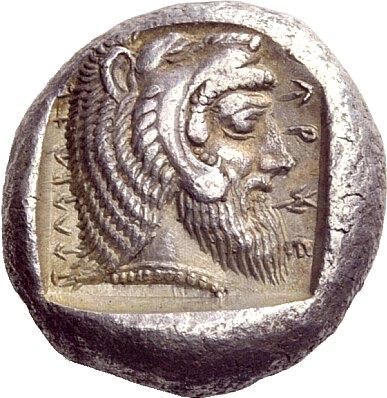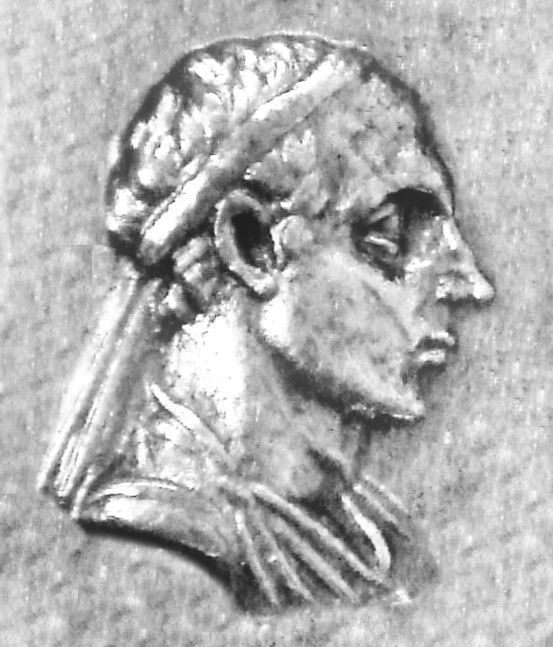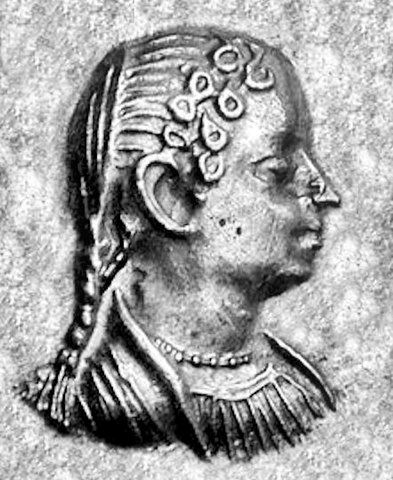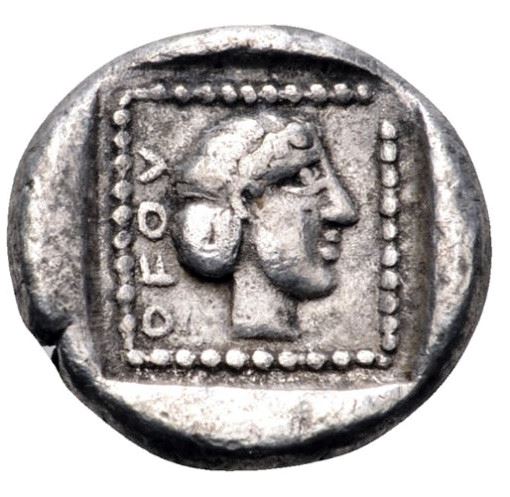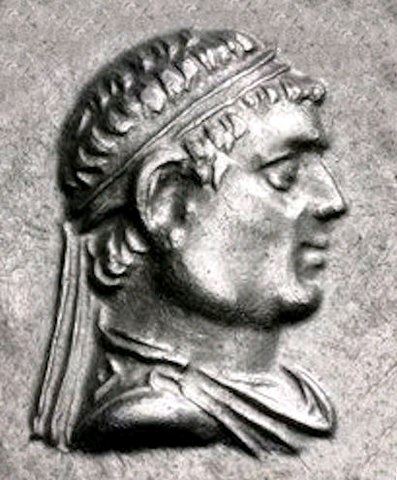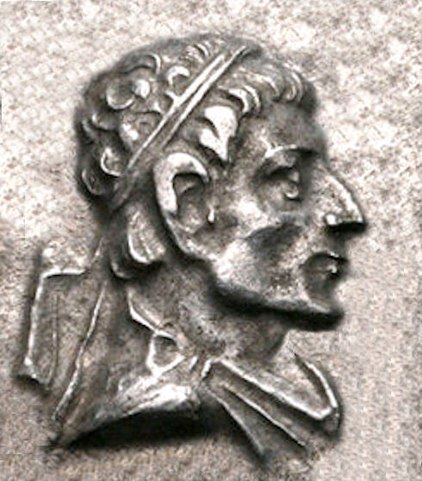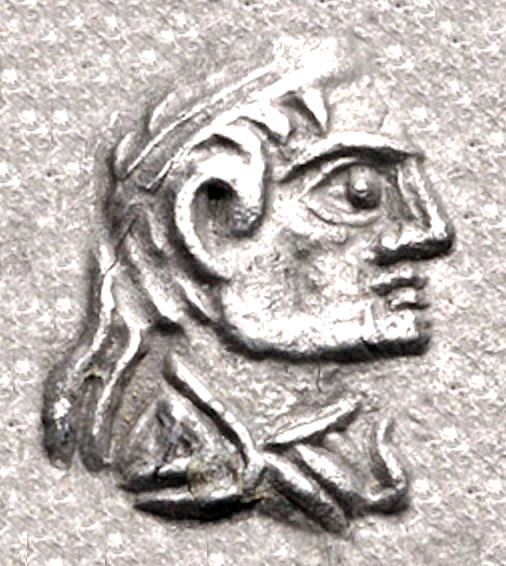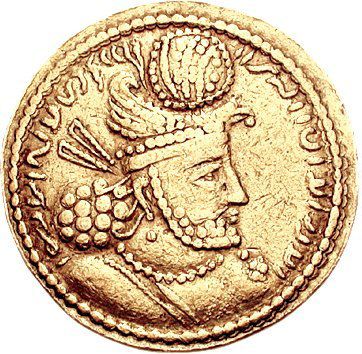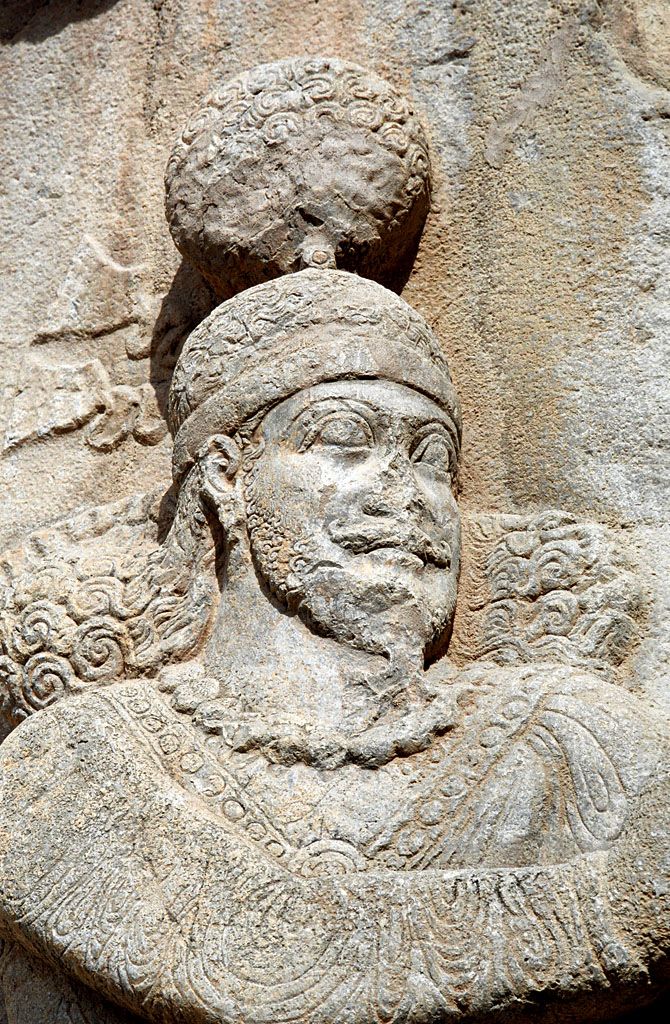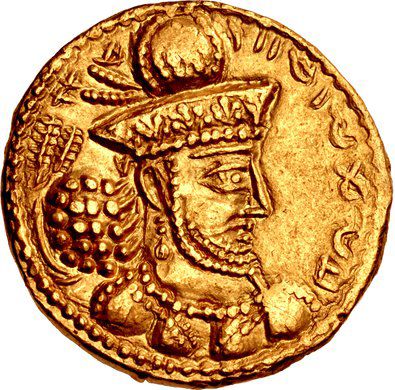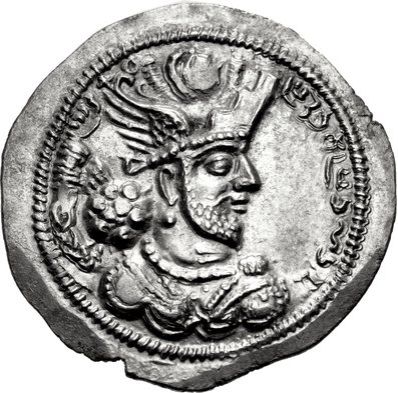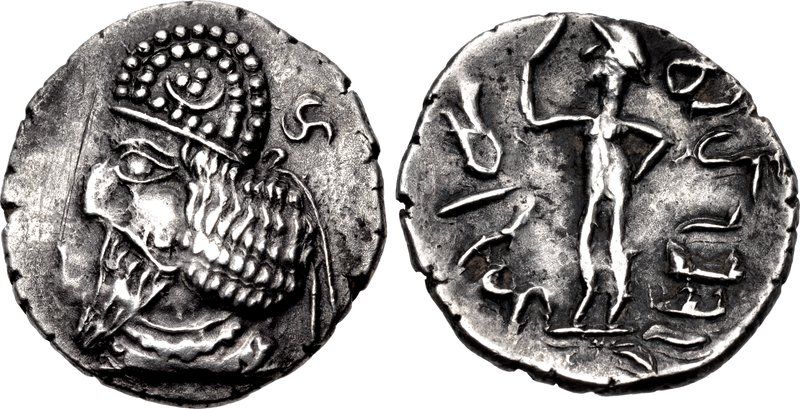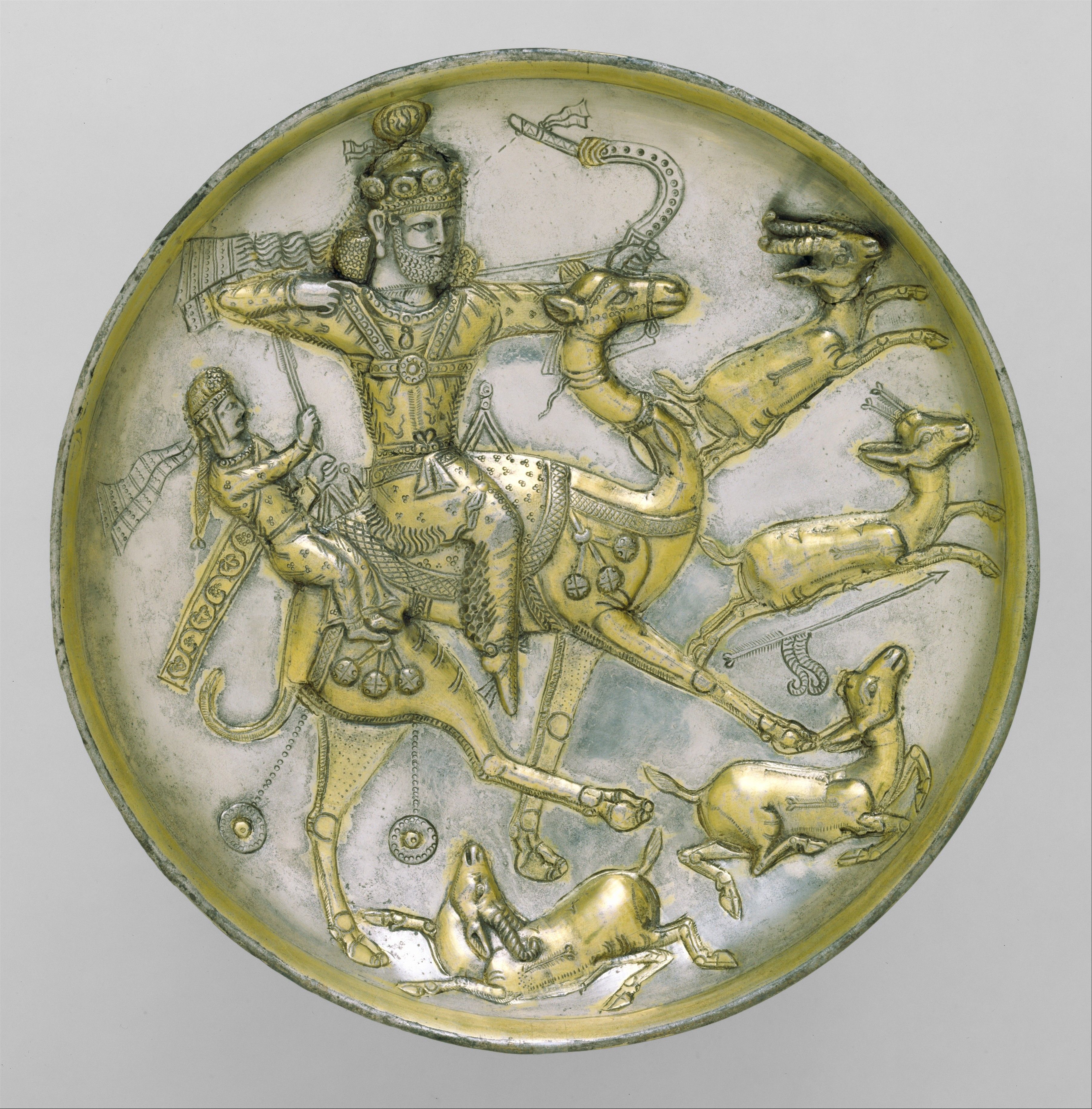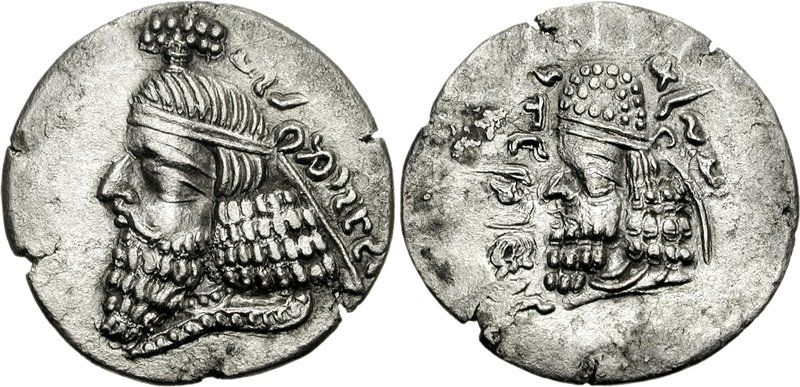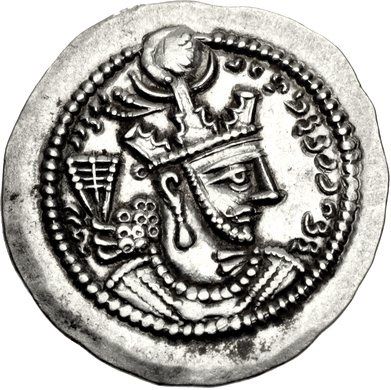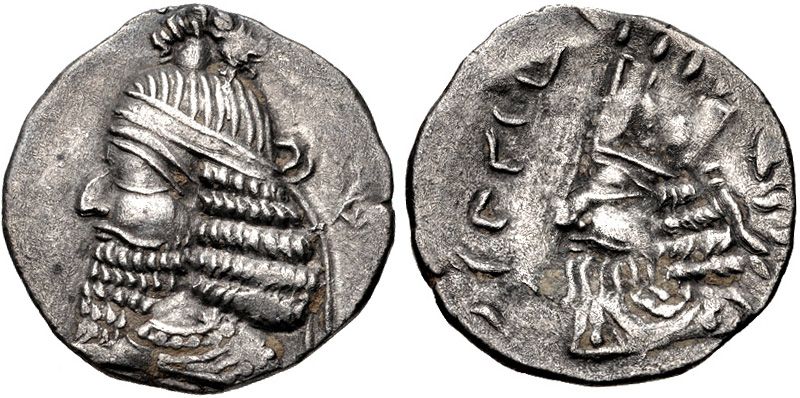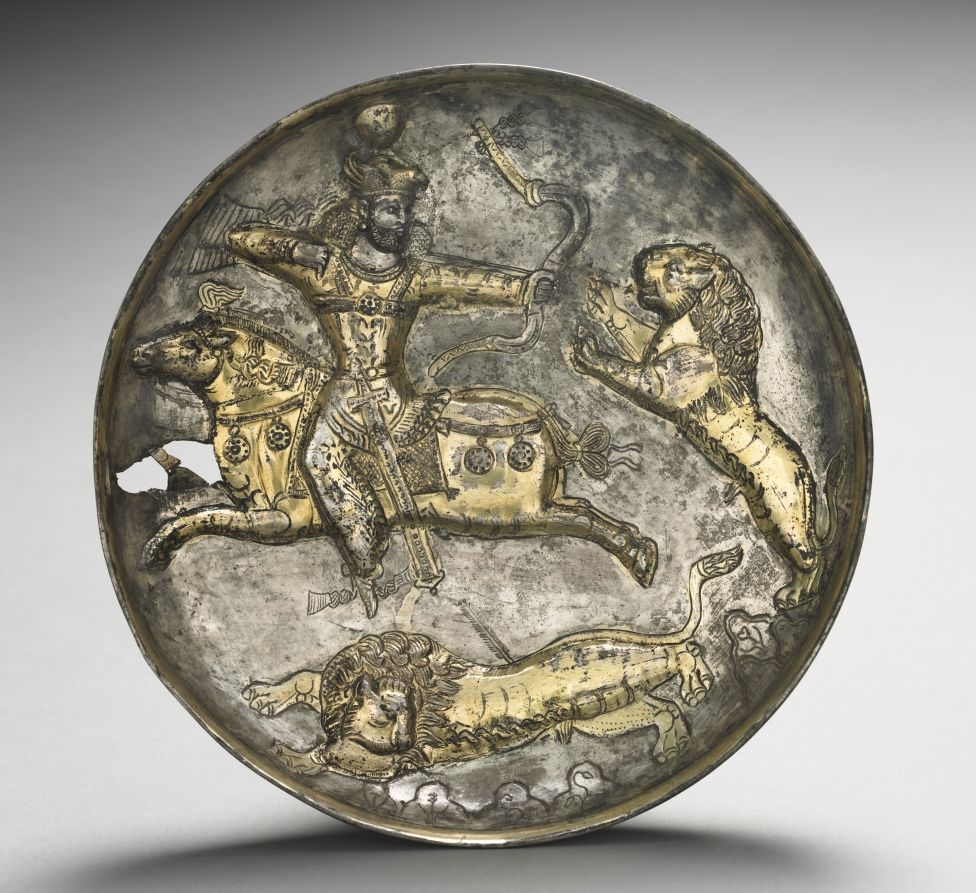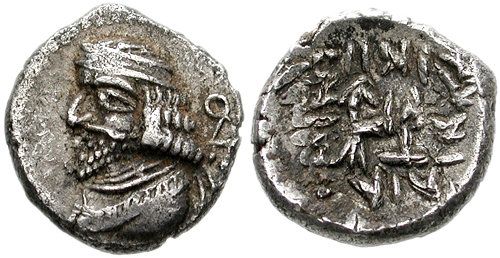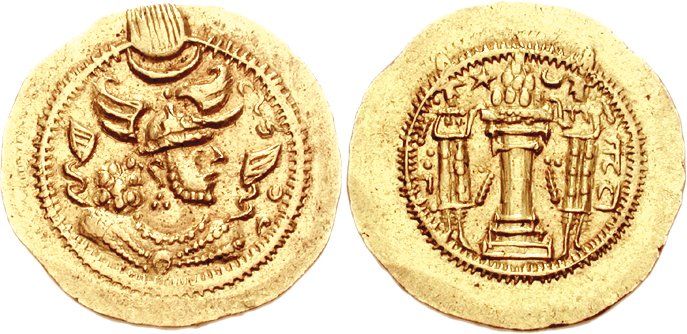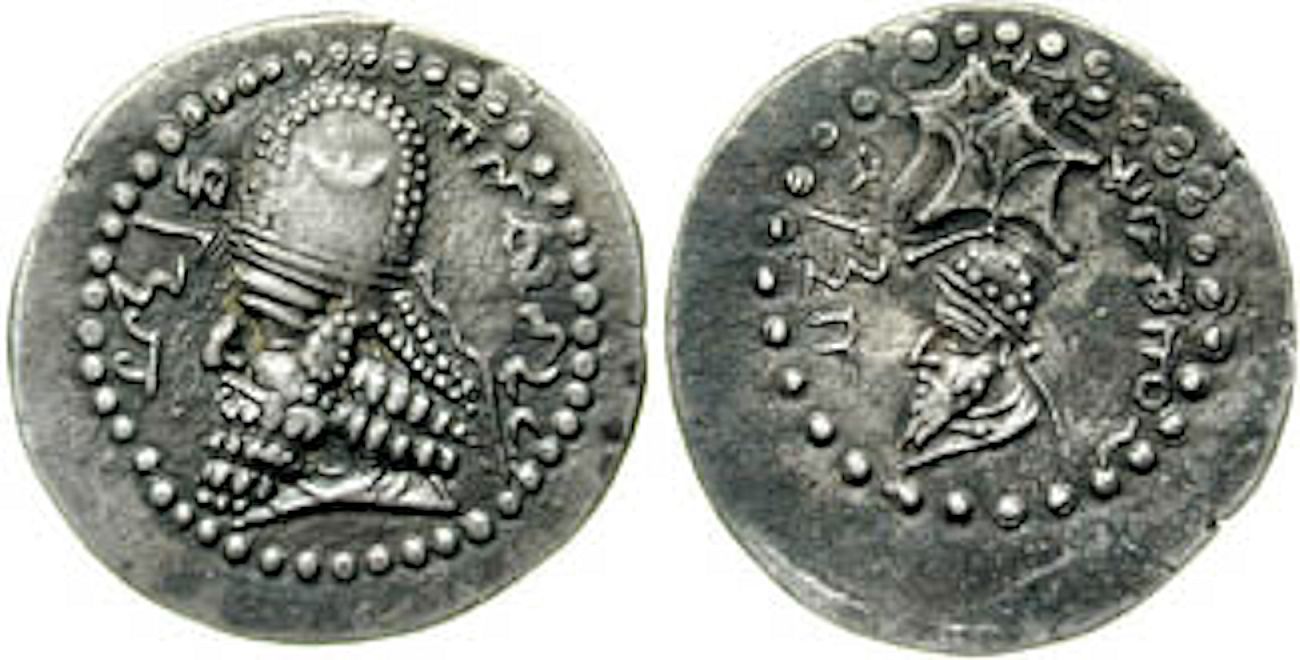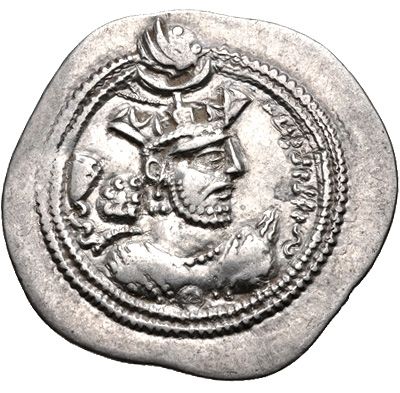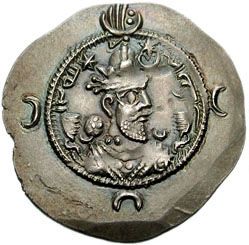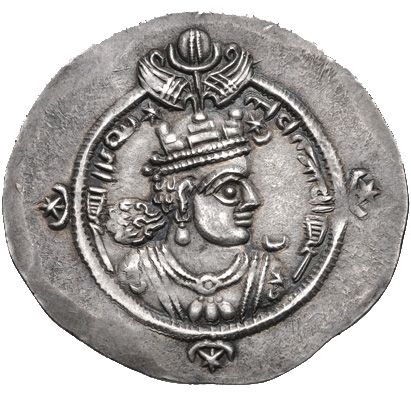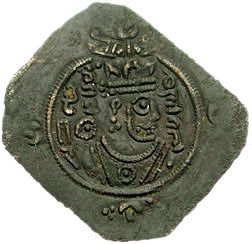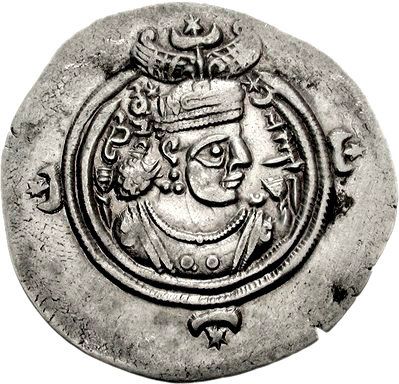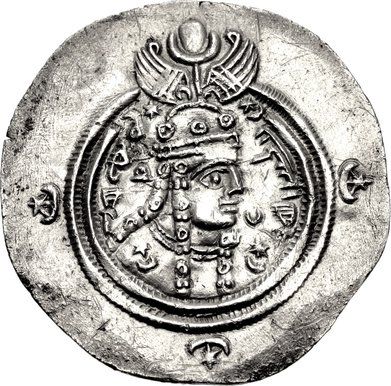This category covers coins from various pre-islamic Eastern realms such as the Nabataean Kingdom and the Indo-Greek Kings.
As such, this category covers a vast geographical and cultural area - and almost a milennium.
Here you will find some of the greatest masterpieces of the Hellenistic world - right next to characteristic stylized Parthian haircuts and decidely alien Nabataean issues.
As such, this category covers a vast geographical and cultural area - and almost a milennium.
Here you will find some of the greatest masterpieces of the Hellenistic world - right next to characteristic stylized Parthian haircuts and decidely alien Nabataean issues.
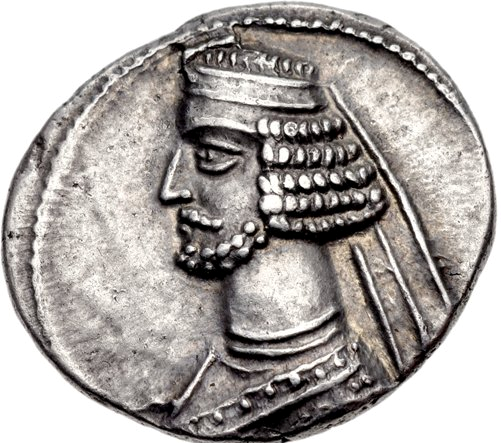
Kanishka I was the emperor of the Kushan dynasty in the second century (c. AD 127–150). He is famous for his military, political, and spiritual achievements.
A descendant of Kushan empire founder Kujula Kadphises, Kanishka came to rule an empire in Bactria extending from Turfan in the Tarim Basin to Pataliputra on the Gangetic plain.
The main capital of his empire was locat...
A descendant of Kushan empire founder Kujula Kadphises, Kanishka came to rule an empire in Bactria extending from Turfan in the Tarim Basin to Pataliputra on the Gangetic plain.
The main capital of his empire was locat...
Mithradates II was king of Parthian Empire from 121 to 91 BC.
He is regarded as the greatest of the Parthian kings, under whom the empire reached its greatest extent.
He is regarded as the greatest of the Parthian kings, under whom the empire reached its greatest extent.
Azes I was an Indo-Scythian ruler who completed the domination of the Scythians in Gandhara.
Although Maues and his successors had conquered the areas of Gandhara, as well as the area of Mathura from 85 BCE forming the Northern Satraps, they were unsuccessful against the Indo-Greek kings remaining behind the Jhelum River in eastern Punjab.
Azes's most lasting legacy was the f...
Although Maues and his successors had conquered the areas of Gandhara, as well as the area of Mathura from 85 BCE forming the Northern Satraps, they were unsuccessful against the Indo-Greek kings remaining behind the Jhelum River in eastern Punjab.
Azes's most lasting legacy was the f...
Eukratides I was one of the most important Greco-Bactrian kings, descendants of dignitaries of Alexander the Great.
He uprooted the Euthydemid dynasty of Greco-Bactrian kings and replaced it with his own lineage. He fought against the Indo-Greek kings, the easternmost Hellenistic rulers in northwestern India, temporarily holding territory as far as the Indus, until he was finally defea...
He uprooted the Euthydemid dynasty of Greco-Bactrian kings and replaced it with his own lineage. He fought against the Indo-Greek kings, the easternmost Hellenistic rulers in northwestern India, temporarily holding territory as far as the Indus, until he was finally defea...
Shapur II was the tenth shah of the Sasanian Empire., and the longest-reigning monarch in Iranian history.
He reigned for his entire 70-year life from 309 to 379.
His reign saw the military resurgence of the country, and the expansion of its territory, which marked the start of the first Sasanian golden era.
Shapur later died in 379, although he had a son named Shapur III, h...
His reign saw the military resurgence of the country, and the expansion of its territory, which marked the start of the first Sasanian golden era.
Shapur later died in 379, although he had a son named Shapur III, h...
Autophradates was a satrap of Lydia under Artaxerxes II, from 391 B.C. until the late 350s.
Some coins with his portrait come from the cities Lampsacus and Cyme, which belonged to his satrapy. In an inscription from Lycia, which was in the sphere of his influence, he is called “Vātafradāta, the Persian satrap.”
Autophradates and Hecatomnos, satrap of Caria, were ordered to pu...
Some coins with his portrait come from the cities Lampsacus and Cyme, which belonged to his satrapy. In an inscription from Lycia, which was in the sphere of his influence, he is called “Vātafradāta, the Persian satrap.”
Autophradates and Hecatomnos, satrap of Caria, were ordered to pu...
Tissaphernes was a Persian soldier and statesman.
He was born in 445 BC and belonged to an important Persian family: he was the grandson of Hydarnes, an eminent Persian general, who was the commander of the Immortals during the time of king Xerxes' invasion of Greece.
In 414 BC, Tissaphernes was assigned by Darius II to suppress the rebellion of Pissuthnes, the Persian satra...
He was born in 445 BC and belonged to an important Persian family: he was the grandson of Hydarnes, an eminent Persian general, who was the commander of the Immortals during the time of king Xerxes' invasion of Greece.
In 414 BC, Tissaphernes was assigned by Darius II to suppress the rebellion of Pissuthnes, the Persian satra...
Abdagases I was an Indo-Parthian king, a nephew of Gondophares evident from some of his coins, who ruled during the first decades of the 1st century AD. Though he never assumed the title of Gondophares, he was an important successor of his uncle, ruling his Indian conquests.
The bilingual coins of Abdagases I feature the kharoshti script where it can be read as "Gudaphara brathaputrasa ...
The bilingual coins of Abdagases I feature the kharoshti script where it can be read as "Gudaphara brathaputrasa ...
Demetrius I was a Greek king of Gandhara. He was the son of the Greco-Bactrian ruler Euthydemus I and succeeded him around 200 BC, after which he conquered extensive areas in what is now Afghanistan and Pakistan, thus creating an Indo-Greek Kingdom far from Hellenistic Greece.
He was never defeated in battle and was posthumously qualified as the Invincible (Aniketos) on the pedigree co...
He was never defeated in battle and was posthumously qualified as the Invincible (Aniketos) on the pedigree co...
Alyattes was the fourth king of the Mermnad dynasty in Lydia, the son of Sadyattes and grandson of Ardys. He was succeeded by his son Croesus.
A battle between his forces and those of Cyaxares, king of Media, was interrupted by the solar eclipse on 28 May 585 BC. After this, a truce was agreed and Alyattes married his daughter Aryenis to Astyages, the son of Cyaxares. The alliance pres...
A battle between his forces and those of Cyaxares, king of Media, was interrupted by the solar eclipse on 28 May 585 BC. After this, a truce was agreed and Alyattes married his daughter Aryenis to Astyages, the son of Cyaxares. The alliance pres...
Amdan Bayyin Yuhaqbiz was a Hymiarite ruler of Saba & Ziridan circa 80-100 AD.
Phraates was ruler of the semi-independent Kingdom of Elymais from c. 70-90 AD. He was the son of either Orodes I or Orodes II.
Phraates is known only from his coins, the first of which bear Greek legends yet feature the king dressed in Parthian costume. Later series also feature Aramaic legends.
Phraates is known only from his coins, the first of which bear Greek legends yet feature the king dressed in Parthian costume. Later series also feature Aramaic legends.
Balakros was the son of Nicanor, one of Alexander the Great's bodyguards. He was appointed satrap of Cilicia after the Battle of Issus, 333 BC.
He fell in battle against the Pisidians in the lifetime of Alexander. It was probably this Balakros who married Phila, the daughter of Antipater, and subsequently the wife of Craterus.
He fell in battle against the Pisidians in the lifetime of Alexander. It was probably this Balakros who married Phila, the daughter of Antipater, and subsequently the wife of Craterus.
Darayan I and his successors were sub-kings of the Parthian Empire. Crescent emblem on top of stylized kyrbasia. Aramaic coin legend d’ryw mlk (𐡃𐡀𐡓𐡉𐡅 𐡌𐡋𐡊, "King Darius").
Hekatomnos was a 4th-century ruler in Caria, who resided in Mylasa and established the Hecatomnid dynasty.
Technically speaking, Hekatomnos was a satrap (governor) under Persian rule, but he was also a locally founded powerful dynast who continued using both Greek language and promoting Greek culture.
He left three sons, Mausolus, Idrieus and Pixodarus, and two daughters, Art...
Technically speaking, Hekatomnos was a satrap (governor) under Persian rule, but he was also a locally founded powerful dynast who continued using both Greek language and promoting Greek culture.
He left three sons, Mausolus, Idrieus and Pixodarus, and two daughters, Art...
Antimachos I was a Baktrian King who is believed to have ruled from ca. 185-170 BC.
He was either defeated during his resistance to the usurper Eucratides, or his main territory was absorbed by the latter upon his death.
Antimachus I issued numerous silver coins on the Attic standard, with his own image in a flat Macedonian kausia hat, and on the reverse Poseidon with his tri...
He was either defeated during his resistance to the usurper Eucratides, or his main territory was absorbed by the latter upon his death.
Antimachus I issued numerous silver coins on the Attic standard, with his own image in a flat Macedonian kausia hat, and on the reverse Poseidon with his tri...
Khusro II was the last great king of the Sasanian Empire, reigning from 590 to 628.
He was the son of Hormizd IV (reigned 579–590) and the grandson of Khosrow I (reigned 531–579). He was the last king of Persia to have a lengthy reign before the Muslim conquest of Iran, which began five years after his death by execution. He lost his throne, then recovered it with Roman help, and, a dec...
He was the son of Hormizd IV (reigned 579–590) and the grandson of Khosrow I (reigned 531–579). He was the last king of Persia to have a lengthy reign before the Muslim conquest of Iran, which began five years after his death by execution. He lost his throne, then recovered it with Roman help, and, a dec...
Orodes II as the king of the Parthian Empire from 57 BC to 37 BC.
He was a son of Phraates III, whom he murdered in 57 BC, assisted by his brother Mithridates. He married a Greek Princess from the Kingdom of Commagene, called Laodice
Orodes' son Pacorus was himself later killed by Ventidius in 38 BC. Orodes, who was deeply afflicted by the death of his gallant son, appointed...
He was a son of Phraates III, whom he murdered in 57 BC, assisted by his brother Mithridates. He married a Greek Princess from the Kingdom of Commagene, called Laodice
Orodes' son Pacorus was himself later killed by Ventidius in 38 BC. Orodes, who was deeply afflicted by the death of his gallant son, appointed...
Pericles or Perikle was the name of the dynast or king of the Lycian city of Limyra during the 370s BC.
We have very little biographical information on Pericles. The name ‘Pericles’ is obviously unusual for a Lycian ruler. It can be attributed to the fact that his family maintained close ties with Athens, possibly with the Athenian Pericles himself. Perhaps some of his ancestors had ser...
We have very little biographical information on Pericles. The name ‘Pericles’ is obviously unusual for a Lycian ruler. It can be attributed to the fact that his family maintained close ties with Athens, possibly with the Athenian Pericles himself. Perhaps some of his ancestors had ser...
Agathocles Dikaios was a Greco-Bactrian/ Indo-Greek king, who reigned between around 190 and 180 BC.
Agathocles might have been a son of Demetrius I, and might have served one of his sub-kings in charge of the Paropamisade between Bactria and India. In that case, he was a grandson of Euthydemus whom he qualified on his coins as Βασιλεὺς Θεός, Basileus Theos (Greek for "God-King").
Agathocles might have been a son of Demetrius I, and might have served one of his sub-kings in charge of the Paropamisade between Bactria and India. In that case, he was a grandson of Euthydemus whom he qualified on his coins as Βασιλεὺς Θεός, Basileus Theos (Greek for "God-King").
Azes II was an Indo-Scythian ruler, the last Scythian king in Gandhara, western Pakistan. His existence has been questioned — did he not exist artefacts attributed to his reign, such as coins, would likely be those Azes I.
After the death of Azes II, the rule of the Indo-Scythians in northwestern India and Pakistan finally crumbled with the conquest of the Kushans, one of the five tribe...
After the death of Azes II, the rule of the Indo-Scythians in northwestern India and Pakistan finally crumbled with the conquest of the Kushans, one of the five tribe...
Kamnaskires-Orodes was ruler of the semi-independent Kingdom of Elymais from c. 100-120 AD. He was the son of Orodes II.
The drachmas of Kamnaskires-Orodes show Aramaic inscriptions. Le Rider suggests that the tetradrachms with Aramaic inscriptions were minted at the former Elymaean capital of Seleucia on the Hedyphon, perhaps mainly for internal circulation.
The drachmas of Kamnaskires-Orodes show Aramaic inscriptions. Le Rider suggests that the tetradrachms with Aramaic inscriptions were minted at the former Elymaean capital of Seleucia on the Hedyphon, perhaps mainly for internal circulation.
Reportedly, Croesus on the death of his father Alyattes faced a rival claimant to the throne in Pantaleon, son of Alyattes by a different mother. Croesus prevailed, and a number of the opposite faction were executed, and their property confiscated. As soon as his reign was secure, Croesus continued his sires' wars against the Asian Greeks, bringing all the Aeolian and Ionian Settlements on the coa...
Mazaeus, Mazday or Mazaios (died 328 BC) was a Persian noble and satrap of Cilicia and later satrap of Babylon for the Achaemenid Empire, a satrapy which he retained under Alexander the Great.
Mazaeus was the second last Persian satrap (governor) of Cilicia. His successor in Cilicia was Arsames, who was ultimately expelled by Alexander the Great.
At the Battle of Gaugamela, M...
Mazaeus was the second last Persian satrap (governor) of Cilicia. His successor in Cilicia was Arsames, who was ultimately expelled by Alexander the Great.
At the Battle of Gaugamela, M...
Mithradates III was king of Parthian Empire from 57–54 BC.
Mithridates was a son of Phraates III, whom he murdered in 57 BC, with the assistance of his brother Orodes. Orodes became king of Parthia and made Mithridates king of Media, a Parthian client state.
On account of his cruelty, Orodes turned on his brother and deposed him. Mithridates was forced to flee from Media to R...
Mithridates was a son of Phraates III, whom he murdered in 57 BC, with the assistance of his brother Orodes. Orodes became king of Parthia and made Mithridates king of Media, a Parthian client state.
On account of his cruelty, Orodes turned on his brother and deposed him. Mithridates was forced to flee from Media to R...
Pantaleon was a Greek king who reigned some time between 190–180 BC in Bactria and India. He was a younger contemporary or successor of the Greco-Bactrian king Demetrius, and is sometimes believed to have been his brother and/or subking.
The scarcity of his coinage indicates a short reign. Known evidence suggests that he was replaced by his (probable) brother or son Agathocles, by whom ...
The scarcity of his coinage indicates a short reign. Known evidence suggests that he was replaced by his (probable) brother or son Agathocles, by whom ...
Sub-king of the Parthian Empire. Aramaic coin legend d’ryw mlk brh wtprdt mlk’ (𐡃𐡀𐡓𐡉𐡅 𐡌𐡋𐡊 𐡁𐡓𐡄 𐡅𐡕𐡐𐡓𐡃𐡕 𐡌𐡋𐡊, "King Darius, son of King Wadfradad").
Also known as Artaxares and Artaxerxes. Declared himself as Shahanshah after defeating Artabanus IV of Parthia at the Battle of Hormizdegan.
Died of natural causes in 242.
Died of natural causes in 242.
Mithrapata was dynast of Lycia in the early 4th century BC, at a time when this part of Anatolia was subject to the Persian, or Achaemenid, Empire.
Present-day knowledge of Lycia in the period of classical antiquity comes mostly from archaeology, in which this region is unusually rich. Believed to have been based at Antiphellus, Mithrapata is known to have competed for power with anothe...
Present-day knowledge of Lycia in the period of classical antiquity comes mostly from archaeology, in which this region is unusually rich. Believed to have been based at Antiphellus, Mithrapata is known to have competed for power with anothe...
Apollodotos I was an Indo-Greek king between either 180 BCE and 160 BCE or 174 and 165 BCE who ruled the western and southern parts of the Indo-Greek kingdom, from Taxila in Punjab to the areas of Sindh and possibly Gujarat.
Apollodotus was not the first to strike bilingual coins outside Bactria, but he was the first king who ruled in India only, and therefore the founder of the proper ...
Apollodotus was not the first to strike bilingual coins outside Bactria, but he was the first king who ruled in India only, and therefore the founder of the proper ...
Vologases III was a Parthian Prince who claimed the throne of the Parthian Empire about 105, in the last days of Pacorus II of Parthia (80–105) and reigned over the eastern portion of the kingdom to 147. He was the son of Vologases II.
The period was one of civil war in the Parthian kingdom; for the early part of his reign Vologases III contended with Pacorus II's legitimate successors ...
The period was one of civil war in the Parthian kingdom; for the early part of his reign Vologases III contended with Pacorus II's legitimate successors ...
Also known as Sapores or Sapor. Co-ruled with his father since 12 April 240. Died of natural causes in May 270.
Vekhssere - also known as Wekhssere - was dynast of Lycia in the mid 5th century BC, at a time when this part of Anatolia was subject to the Persian, or Achaemenid, Empire.
Present-day knowledge of Lycia in the period of classical antiquity comes mostly from archaeology, in which this region is unusually rich.
Vekhssere I seems to have been based in Xanthos.
Present-day knowledge of Lycia in the period of classical antiquity comes mostly from archaeology, in which this region is unusually rich.
Vekhssere I seems to have been based in Xanthos.
Demetrius II was a Greco-Bactrian/Indo-Greek king who ruled briefly during the 2nd century BC. Little is known about him and there are different views about how to date him. Earlier authors such as Tarn and Narain saw him as a son and sub-king of Demetrius I, but this view has now been abandoned.
Demetrius II issued only silver and mostly tetradrachms, another trait which he has in comm...
Demetrius II issued only silver and mostly tetradrachms, another trait which he has in comm...
Sub-king of the Parthian Empire. Son of Darayan II.
Also known as Oromastes. Son of previous king. Reigned only for 1 year.
Kherei was a Dynast in Lycia from circa 440-410 BC. He was apparently the brother of the previous Dynast - Kheriga.
Kherei is presumably identical to the Kherei who is the hero on the tri-lingual Xanthos Stele, which is written in Greek and two Luwian languages; Lycian & Milyan.
All of this is very speculative, however, as is most of Lycian history.
Kherei is presumably identical to the Kherei who is the hero on the tri-lingual Xanthos Stele, which is written in Greek and two Luwian languages; Lycian & Milyan.
All of this is very speculative, however, as is most of Lycian history.
Menandros I was an Indo-Greek King who ruled the eastern dominions of the divided Greek empire of Bactria and large parts of modern day India.
His capital is supposed to have been Sagala, a prosperous city in northern Punjab, Pakistan. He subsequently travelled across northern India and visited the Maurayan capital of Patna. Any plans of conquering the capital were put aside as Eucratid...
His capital is supposed to have been Sagala, a prosperous city in northern Punjab, Pakistan. He subsequently travelled across northern India and visited the Maurayan capital of Patna. Any plans of conquering the capital were put aside as Eucratid...
Sub-king of the Parthian Empire. Son of previous king Vahshir I.
Brother of the previous king. Committed the persecution of Manichaeism, including the death of Mani. Died of disease/natural causes in September 274.
Agathokleia was an Indo-Greek queen who ruled in parts of northern India in the 2nd-century BC.
The traditional view is that Agathokleia was the widow of Menander I. In the civil wars after Menander's death, the Indo-Greek empire was divided, with Agathokleia and her young son Strato maintaining themselves in the eastern territories of Gandhara and Punjab.
The modern view sug...
The traditional view is that Agathokleia was the widow of Menander I. In the civil wars after Menander's death, the Indo-Greek empire was divided, with Agathokleia and her young son Strato maintaining themselves in the eastern territories of Gandhara and Punjab.
The modern view sug...
Sub-king of the Parthian Empire.
Son of the previous king. Died of natural causes in 293.
Uvug or Uwug seems to have been a Lycian dynast. His coins are attributed to 470-440 BC. He may have been a local Dynast, rather than the master of all of Lycia.
Coins of Uwug seem to have sometimes been struck on a Carian weight standard.
Coins of Uwug seem to have sometimes been struck on a Carian weight standard.
Strato I was an Indo-Greek king who was the son of the Indo-Greek queen Agathokleia, who presumably acted as his regent during his early years after Strato's father, another Indo-Greek king, was killed.
Until recently, consensus was that he ruled between c. 130–110 BCE in Northern India and that his father was the great king Menander I. Menander ruled the entire Indo-Greek empire, but i...
Until recently, consensus was that he ruled between c. 130–110 BCE in Northern India and that his father was the great king Menander I. Menander ruled the entire Indo-Greek empire, but i...
Sub-king of the Parthian Empire. Son of Ardakhshir II.
He was son and successor of Bahram II. He was appointed viceroy to the province of Sakastan after Bahram II's re-conquest of it sometime in the 280s.
Heliokles II is thought to have been one of the later Indo-Greek kings and a relative of the Bactrian king Heliocles I. Bopearachchi and R. C. Senior seem to agree that he ruled ca 95–80 BC.
Heliocles II seems to have been engaged in a series of wars with Strato I in Gandhara and Punjab; the two share several mintmarks and Heliocles II overstruck many of his coins. During this period, a...
Heliocles II seems to have been engaged in a series of wars with Strato I in Gandhara and Punjab; the two share several mintmarks and Heliocles II overstruck many of his coins. During this period, a...
Sub-king of the Parthian Empire. Son of previous king Nambed.
Also known as Narses or Narseus. He was the son of Shapur I . During the rule of his father, Narseh had served as the governor of Sakastan, Sindh and Turan. Prior to becoming shah of Iran, he held the title of "Great King of Armenia". Enthroned after seizing power from Bahram III in a rebellion led against him
Zoilos II was an Indo-Greek king who ruled from Sagala in eastern Punjab. Bopearachchi dates his reign to c. 55–35 BC, a date approximately supported by R. C. Senior. The name is often Latinized as Zoilus. It is possible that some of his coins were issued by a separate king, Zoilos III.
Zoilos seems to have been one of the rulers who succeeded the last important Indo-Greek king Apollodo...
Zoilos seems to have been one of the rulers who succeeded the last important Indo-Greek king Apollodo...
Sub-king of the Parthian Empire
Enthroned after abdicating the throne from his father.
Hermaeus Soter or Hermaios Soter (epithet means "the Saviour") was a Western Indo-Greek king of the Eucratid Dynasty, who ruled the territory of Paropamisade in the Hindu-Kush region, with his capital in Alexandria of the Caucasus (near today's Kabul, Afghanistan). Bopearachchi dates Hermaeus to c. 90–70 BCE and R. C. Senior to c. 95–80 BCE.
Hermaeus seems to have been successor of Phi...
Hermaeus seems to have been successor of Phi...
Sub-king of the Parthian Empire.
He was the brother of his predecessor, Shapur II, under whom he had served as governor-king of Nodardashiragan, where he fought alongside his brother against the Romans. Ardashir II was appointed as his brother's successor to rule interimly till the latter's son Shapur III reached adulthood.
Sub-king of the Parthian Empire
He was the son of Shapur II and succeeded his uncle Ardashir II. He ultimately met the same fate as his predecessor, being killed by the nobility.
Sub-king of the Parthian Empire. Son of previous king Manchihr I.
He was the son and successor of the previous king Shapur III.
Sub-king of the Parthian Empire. Son of previous king Ardakhshir III.
Sub-king of the Parthian Empire.
The son of Yazdegerd I, Bahram was exiled at an early age to the Lahkmid court in al-Hira, where he was raised under the tutelage of the Lakhmid kings. After the assassination of Yazdegerd I, Bahram hurried to the Sasanian capital of Ctesiphon with a Lakhmid army, and won the favour of the nobles and priests, according to a long-existing popular legend, after withstanding a trial against two lions.
Sub-king of the Parthian Empire. Son of Manchihr II.
Son of the previous king Bahram V.
Sub-king of the Parthian Empire. Son of previous king Manchihr III.
He was the son and successor of Yazdegerd II. His reign was marked by the rebellion of his younger brother Peroz I, who with the aid of one the Seven Great Houses of Iran, the House of Mihran, and the eastern neighbours of the Sasanians, the Hephthalites, had him captured and executed.
Sub-king of the Parthian Empire. The last of Bazarangids.
He was the son of Yazdegerd II and brother of Hormizd III. During his reign, he successfully quelled a rebellion in Caucasian Albania in the west, and put an end to the Kidarites in the east. He was, however, less successful in handling the Hephthalites, who had taken the Kidarites' place. This eventually resulted in a disastrous defeat near Balkh, where Peroz was killed.
Shapur was an Iranian prince, who was the penultimate King of Persis from 207–210 CE to 211/2 CE. He was succeeded by his younger brother Ardashir I, who founded the Sasanian Empire.
He was the brother and successor of Peroz I (r. 459–484), who had been defeated and killed by a Hephthalite army near Balkh.
A son of Peroz I, he was crowned by the nobles to replace his deposed and unpopular uncle Balash.
Inheriting a declining empire where the authority and status of the Sasanian kings had largely ended, Kavad tried to reorganize his empire by introducing many reforms whose implementation was completed by his son and successor Khosrow I. They were made possible by Kavad's use of the Mazdak...
Inheriting a declining empire where the authority and status of the Sasanian kings had largely ended, Kavad tried to reorganize his empire by introducing many reforms whose implementation was completed by his son and successor Khosrow I. They were made possible by Kavad's use of the Mazdak...
He was a son of Peroz I and younger brother of Kavad I. Jamasp was installed on the Sasanian throne upon the deposition of the latter by the nobility and clergy.
Khosrow I was known for his character, virtues and knowledge. During his ambitious reign, he continued his father's project of making major reforms in the social, military, and economic aspects of the empire, increasing the welfare and the revenues, establishing a professional army, and founding or rebuilding many cities, palaces, and infrastructures. He was interested in literature and philosophy...
He was the son and successor of Khosrow I and his mother was a Khazar princess. During his reign, Hormizd IV had the high aristocracy and Zoroastrian priesthood slaughtered, whilst supporting the landed gentry (the dehqan). His reign was marked by constant warfare: to the west, he fought a long and indecisive war with the Byzantine Empire, which had been ongoing since the reign of his father; and ...
Son of general Bahram Gushnasp and hailing from the noble House of Mihran, Bahram began his career as the governor of Ray, and was promoted to the army chief (spahbed) of the northwestern portions of the empire after capturing the Byzantine stronghold of Dara, fighting in the war of 572–591. After a massive Hephthalite-Turkic invasion of the eastern Sasanian domains in 588, he was appointed as the...
He was a Parthian dynast of the Ispahbudhan house, and maternal uncle of Khosrow II. Vistahm helped Khosrow regain his throne after the rebellion of another Parthian noble Bahram Chobin, of House of Mihran, but later led a revolt himself, and ruled independently over a region which encompassed the entire Iranian East until he was defeated by Khosrow and his allies.
He was the son of Khosrow II whom he succeeded after having him overthrown in a coup d'état. Kavad's reign is seen as a turning point in Sasanian history, and has been argued by some scholars as playing a key role in the fall of the Sasanian Empire.
Ardashir was the son of king Kavad II and Anzoy, who was a princess from the Byzantine Empire, which made Ardashir less popular among the Iranians, who had recently been in a long and devastating war against the Byzantines. In 628, a devastating plague spread through western Iran, which claimed the lives of half of the population, including Kavad II himself.
He usurped the throne from Ardashir III, and was killed by Iranian nobles after forty days. Before usurping the Sasanian throne he was a general (spahbed) under Khosrow II. He is furthermore noted for his important role during the climactic Byzantine–Sasanian War of 602–628, and the events that followed afterwards.
He was a Sasanian rival claimant who briefly ruled a part of Khorasan for a few months in 630. In some sources he has been described as a son of Kavad II, whilst other state that he was a son of Khosrow II.

